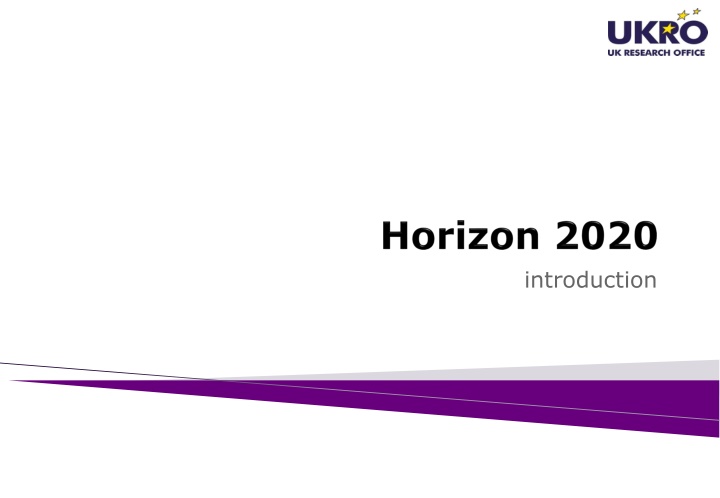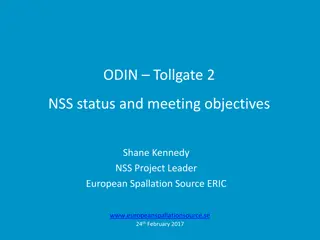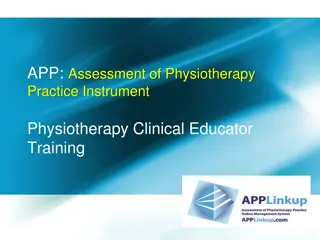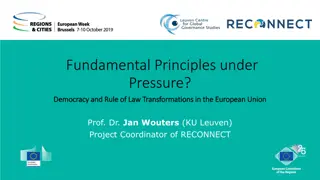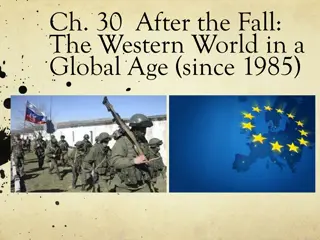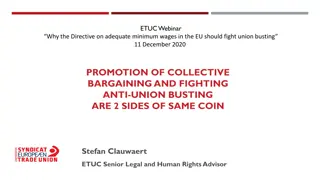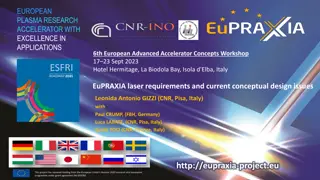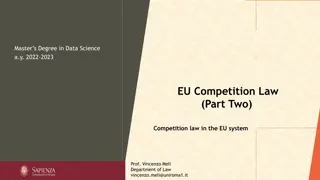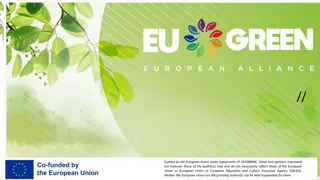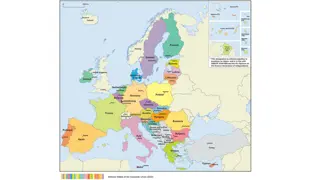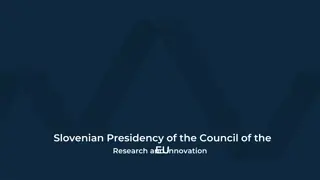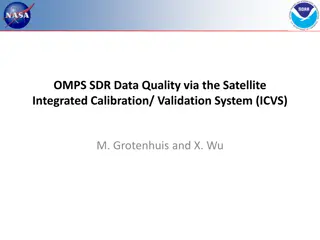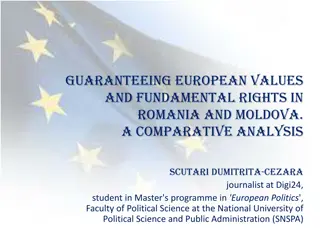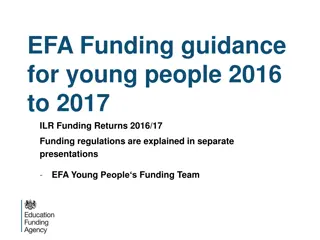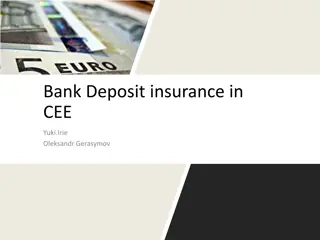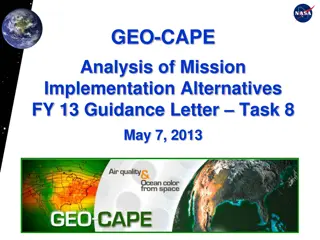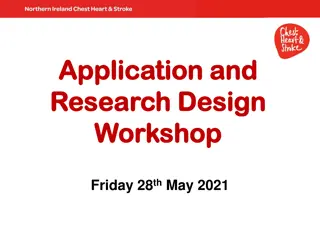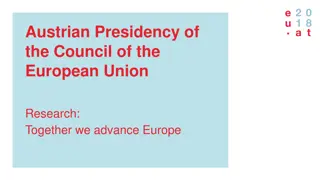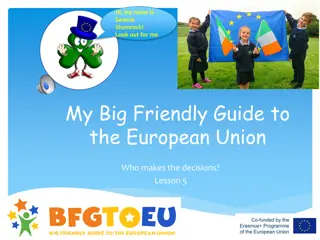European Union's Funding Instrument for Research and Innovation: A Closer Look
European Union's funding instrument for research and innovation from 2014-2020 with a budget of EUR 70.2 billion. This program focuses on societal challenges such as health, clean energy, food security, and integrated transport. It aims to simplify access for all and emphasizes a transition from basic research to market implementation. The program consists of pillars like Excellent Science, Industrial Leadership, and Societal Challenges, each addressing specific objectives and supporting different sectors.
Download Presentation

Please find below an Image/Link to download the presentation.
The content on the website is provided AS IS for your information and personal use only. It may not be sold, licensed, or shared on other websites without obtaining consent from the author.If you encounter any issues during the download, it is possible that the publisher has removed the file from their server.
You are allowed to download the files provided on this website for personal or commercial use, subject to the condition that they are used lawfully. All files are the property of their respective owners.
The content on the website is provided AS IS for your information and personal use only. It may not be sold, licensed, or shared on other websites without obtaining consent from the author.
E N D
Presentation Transcript
The European Unions funding instrument for research and innovation from 2014-2020 Budget of EUR 70,2 billion From research to innovation from basic research to bringing ideas to the market Focus on societal challenges EU society is facing (e.g. health, clean energy, food security, integrated transport) Promise of simplified access for all
Excellent Science Industrial Leadership Societal Challenges Health and Wellbeing European Research Council (ERC) Leadership in Enabling and Industrial Technologies (LEIT) - ICT, KETs, Space Food security Future and Emerging Technologies (FET) Transport Energy Marie Sk odowska-Curie Actions (MSCA) Climate action Access to Risk Finance Societies Research Infrastructures Security Innovation in SMEs Widening Participation; Science with and for Society European Institute of Innovation and Technology (EIT) Joint Research Centre (JRC) EURATOM
Smart cities and communities Smart cities and communities Sustainable food security Sustainable food security Water innovation Water innovation Personalising health and care Personalising health and care New ideas for Europe New ideas for Europe Blue growth Blue growth Disaster resilience Disaster resilience Competitive low- - carbon energy Competitive low carbon energy Digital security Digital security Waste Waste Mobility for Mobility for growth growth Energy Efficiency Energy Efficiency
Excellent Science Competitive Industries Better Society
Clear distinction between funding for bottom-up, excellence- based research (Pillar 1: Excellent Science) and research addressing specific challenges (Pillar 3: Societal Challenges) Dedicated part of the programme targeted primarily at Small and Medium-Sized Enterprises (SMEs) (Pillar 2: Industrial Leadership) Programme integrates funding for research and innovation projects funding for innovation projects within all 3 pillars Clear and detailed definitions of each pillar s key objectives
FP7 Horizon 2020 Integrates FP, EIT, CIP Societal Challenges Strong industry focus overall Covering the entire cycle from basic idea to market Single reimbursement rate for all Framework Programme Research themes SME participation important Growing importance of innovation Range of funding rates, complex rules
Two-year work programmes for 2014-15 Harmonised structure across all EC Directorate-Generals Strategic Programme defines overall focus areas Topics structure: Specific challenge , Scope , Expected Impact
28 EU Member States (Croatia joined in 2013) Associate Countries (similar list to FP7 expected) Still under negotiation Some might not sign agreement in time for Horizon 2020 start but can still apply as long as the agreement is signed in time for grant signature. Third countries (funding will depend on GDP) BRIC no longer eligible for funding
Traditional multi-national, multi-partner collaborative projects 100% - predominantly research 70% - largely closer to market innovation projects Traditional multi-national, multi-partner support actions 100% or 70% SMEs only research can be subcontracted to HEIs Vehicle to pursue specific technological roadmap. Part funded by industry. EU funding element from Horizon 2020. Issue research calls same funding regime as Horizon 2020 Research programmes run by network of national funders in specific field part funded by EU from Horizon 2020. Issue research calls on their own funding regimes All or nothing specific competitive calls content varies Non-competitive actions Non-competitive actions CP: CP: Collaborative Project Collaborative Project CSA: Coordination CSA: Coordination and Support Action and Support Action SME Instrument SME Instrument cPPP cPPP: : contractual Public/Private partnership contractual Public/Private partnership ERANET ERANET Prizes PCP: Prizes PCP: Pre Pre- -contractual procurement contractual procurement PPI: Public procurement PPI: Public procurement of innovative solutions of innovative solutions
European Research Council Research Infrastructures Marie Future and Emerging Technologies Sklodowska- Curie Actions
Total budget = 21.6 billion Brings the four programmes together for first time New Committee structure: one Programme Committee for ERC / MSCA / FET; one for RI Integration under one pillar should bring greater cohesion Overall objective: to strengthen the excellence of European research.
The ERC seeks to fund the best frontier research proposals submitted by excellent researchers, with excellence as the single peer review criterion. Will fund projects led by a Principal Investigator, if necessary supported by a team (no need for pan-European collaboration). Will operate on a bottom-up basis, without pre-determined research priorities. 25 panels in 3 domains which proposals can be submitted to: Physical Sciences and Engineering Life Sciences Social Sciences and Humanities
Starting Grants Consolidator Grants Starting Grants Consolidator Grants Advanced Advanced Grants Grants Synergy Grants Synergy Grants Proof Proof of Concept of Concept Please see the ERC s April 2013 statement on the timing of the 2014 calls: http://erc.europa.eu/update-ERC-calls-proposals-2014
Starting Grants Consolidator Grants Starting Grants Consolidator Grants Expected to continue and to be allocated the largest amount of funding: The ERC shall give particular priority to assisting excellent starting researchers to make the transition to independence by providing adequate support at the critical stage when they are setting up or consolidating their own research team or programme . The current eligibility windows for Principal Investigators (2 to 7 years post-PhD for Starting Grants, 7 to 12 years post-PhD for Consolidator Grants) are expected to remain the same*. *Please note that this is still to be confirmed within the final Horizon 2020 legislative text.
Advanced Grants Advanced Grants Expected to be maintained within the new programme: The ERC will also continue to provide appropriate levels of support for established researchers The current eligibility requirements (an excellent track record of research achievements during the last 10 years, no specific PhD requirement) are expected to remain the same*. *Please note that this is still to be confirmed within the final Horizon 2020 legislative text.
Synergy Grants Synergy Grants Funds ambitious proposals submitted by a group of 2 to 4 PIs No call for this pilot scheme is expected to be launched in 2014 But could also continue within Horizon 2020, as a limited part of the ERC s portfolio of schemes: The ERC shall also give support, as necessary, to emerging new ways of working in the scientific world with the potential to create breakthrough results and facilitates exploration of the commercial and social innovation potential of the research which it funds .
Proof Proof of Concept of Concept Scheme for ERC grant holders to establish the innovation potential of an idea developed during the course of an ERC- funded project Maximum grant: 150,000 Expected to continue within Horizon 2020
Marie Skodowska-Curie Actions
Operates in a bottom-up basis, open to all research and innovation areas Mobility is a key requirement Key areas supported: Fostering new skills by means of excellent initial training of researchers Nurturing excellence by means of cross-border and cross-sector mobility Stimulating innovation by means of cross-fertilisation of knowledge Co-funding of activities
FP7 FP7 Horizon 2020 Horizon 2020 Innovative Training Networks (Early Stage Researchers) ITN ITN ITN IEF IOF IIF CIG IAPP IRSES Individual Fellowships (Experienced Researchers) IF IF Research and Innovation Staff Exchange (Exchange of Staff) RISE RISE Cofunding or regional, national and international programmes COFUND COFUND COFUND
Participants defined as academic and non-academic Early stage researchers (ESRs) only The Innovative Doctoral Programme strand will move to the COFUND scheme. The ITN scheme consists of 3 strands: European Training Networks (minimum of three participants) Joint Doctorates (at least three academic participants who can deliver a doctoral degree) European Industrial Doctorates (one academic participant and one non-academic participant)
2 strands in IF scheme: Outgoing Fellowship - (MS/AC to third country), with mandatory return phase European Fellowship - (any country to MS/AC) 2 main changes to FP7: Optional intersectoral secondment in a MS/AC during the fellowship ICPC return phase could be removed
Focused on exchange of staff Amalgamation of IAPP and IRSES with 7 main changes Project to be based on new or existing joint research project Participants - academic / non-academic NOT public sector / private sector Minimum 3 participants - 3 different countries (2 MS/AC) If all participants MS/AC, minimum 1 academic +1 non-academic participant from different countries Secondment period - 1 to 12 months- doesn t need to be continuous One simplified funding system- unit cost with country co-efficient factors Projects between 50-500 research months
Supports 2 programmes: Doctoral programmes (Innovative Doctoral Programmes) Fellowship programmes Funding model in COFUND will differ from FP7 Standard unit costs - fixed amounts per researcher /year Maximum EU contribution to single legal entity/ year Programmes up to 60 months Shorter time to grant All researchers should be covered by full social security Principles of the Charter and Code should set out provisions for ESRs
Website www.ukro.ac.uk/mariecurie UKRO Subscriber web pages on Marie Curie Actions www.ukro.ac.uk/subscriber/fp7/people Commission s Marie Curie Actions website ec.europa.eu/research/mariecurieactions
Expanded from ICT and Energy to be used as cross-cutting funding scheme Supports frontier research: alternative ideas, concepts or paradigms of risky or non-conventional nature FET Open FET FET High Performance Computing PPP Proactive Flagships Fostering novel ideas Nurturing emerging themes and communities 9 Topics + CSA Tackling grand Interdisciplinary science and technology challenges Graphene Human Brain Support to Flagships HPC towards Exascale 7 Topics
Non-topical and Non-descriptive Characteristics Long Term Vision and S&T targeted Foundational develop the basis for a new kind of technology High-Risk complex projects that cross multiple disciplines Novelty new ideas and concepts, not incremental Interdisciplinary Two Types of Projects Early Proof of Principle of a new technological possibility, together with its scientific basis, as foundational contribution for a radically new line of science and technology research; or Establish a solid baseline of feasibility and potential for a new technological direction, ready for early take-up with an early-stage emerging innovation ecosystem of high-potential actors. Involve new and high-potential research and innovation players
Objectives Nine Candidate Topics Exploratory: to stimulate the exploration of a variety of directions by building up critical mass of researchers and groups Time for Time Constructive Symbiosis Adaptive bottom-up construction New possibilities at the nano-bio-chem interface Knowing, doing, being Ecological technology Exploiting light-matter interactions Quantum technologies Global Science System 1. 2. 3. 4. Path finding: translating science into concrete technological directions by projects that build on proof of concept, while high risk, to take them to the next level of development 5. 6. 7. 8. 9.
FET pages on CORDIS http://cordis.europa.eu/fp7/ict/programme/fet_en.html
Strategic investments in key technologies (e.g. advanced manufacturing, micro-electronics) underpin innovation across existing and emerging sectors Europe needs to attract more private investment in research and innovation Europe needs more innovative SMEs to create growth and jobs
Leadership in Industrial and Enabling Technologies (LEIT)
Emphasis on combining enabling technologies to find solutions for societal challenges particularly energy efficiency targets, sustainability and climate change objectives Cross-cutting themes: Integration of technologies Demonstration of capacity to make and deliver innovative products and services User and customer pilots to prove feasibility and added value
Collaborative projects similar to NMP theme under FP7 Multi-disciplinary, multi KET approach Pre-commercial / pre-competitive stage funding Focus on tackling common technological barriers Expectation of strong SME involvement Public Private Partnerships: PPP 50% of LEIT budget Leading role for industry in defining research priorities Cross reference to KET focus areas ICT strongly featured SME targeted / demo projects
Strong focus on industrial involvement and applied research Developing industrial capacity in focus areas: Key Enabling Technologies (KETs) Micro- and nano-electronics, Photonics Nanotechnologies Advanced Materials Biotechnology Advanced Manufacturing and Processing
ICT in Leadership in enabling and industrial technologies (LEIT)
New generation of components and systems Advanced Computing Future Internet Content Micro- and nano-electronic technologies/ Photonics technologies and information management Robotics Cross-cutting and horizontal activities and International Co-operation Future Internet Public Private Partnership
Six Challenges + international co-operation, horizontal activities and Future Internet PPP Two Key Enabling Technologies in LEIT: Micro-/nanoelectronics and photonics Cross cutting KETs actions to develop innovative products
A new generation of components and systems Reinforcing EU stronghold positions in electronics, microsystems and embedded systems. From smart integrated components to cyber-physical systems Advanced Computing Reinforcing and expanding EU low-power ICT industrial strengths Complementarities with FET, Research infrastructures, JTI ECSEL Future internet Address most critical technical aspects for the internet to be ready to support future expectations
Content technologies and information management Strengthen EU position as provider of digital content and data products and services New tools to model, analyse and visualise vast amounts of data Big data, machine translation, tools for creative industries Robotics Advance robot capabilities
Micro- and nanoelectronics and photonics Addresses research in the two Horizon 2020 ICT Key Enabling Technologies (KETs) Micro- and nanoelectronics KET implemented by JTI ECSEL: multi-disciplinary industry-driven research technology development (Technology Readiness Levels 2-8) within European Commission: generic technology development focused on advanced research/technology development (lower Technology Readiness Levels) Photonics KET covers photonics Public Private Partnership (PPP) and activities address the whole innovation chain
Mostly CPs (100/70%) and some inducement prizes Most topics include funding for different project types, often have a strand on RTD actions and one on Innovation actions within the same topic Topic for cross-cutting ICT KETs Factories of the Future (PPP FoF) Call 3 ICT topics (+Advanced Manufacturing topics)
